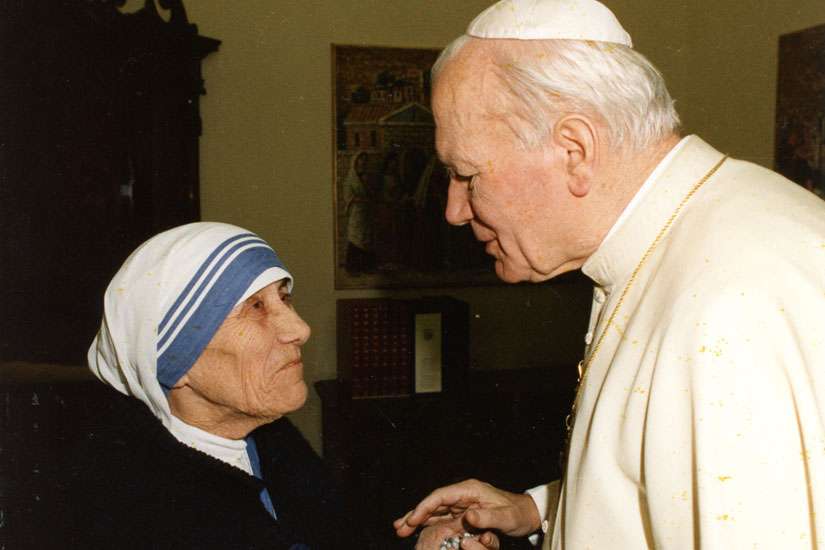When Pope Francis declares Mother Teresa a saint Sept. 4, granting to her the rare honour of a solo canonization ceremony, he will complete the set of Teresas, a quartet of saints who have given shape to Catholicism in our time.
Agnes Bojaxhiu was born in Albania in 1910. As a young girl she was given the affectionate nickname Gonxha, which means “flowerbud” or “little flower.” Providence from a young age was thus evident, for when Agnes took her religious name, she chose as her patron the Little Flower, Thérèse of Lisieux. Mother Teresa was inspired by the “little way” of the Little Flower, to do “ordinary things with extraordinary love.” Thérèse, who desired to be a missionary but never left her cloister, was named patron of the missions, and found in Mother Teresa the fulfilment of her desires. The Missionaries of Charity would be the fastest growing missionary order of the 20th century, and they would be missionaries precisely of charity — of love, just as Thérèse of Lisieux understood her vocation to “be love” in the heart of the Church. The most popular saint of the 20th century would be the patron of the most famous Catholic of the same century — and both would teach that the enormity of God’s love is discovered in the littleness of everyday life.
In 1998, on the 50th anniversary of Karol Wojtyła’s doctorate from Rome’s Angelicum University, Cardinal Joseph Ratzinger spoke about how God’s truth and God’s love are inseparable; all truth has its final end in love of God. To demonstrate that, Ratzinger said that we need only to see what John Paul did with the two Teresas of his pontificate: Thérèse of Lisieux and Teresa Benedicta of the Cross (Edith Stein).
“He made the saint a doctor and the doctor a saint,” explained Ratzinger.
Thérèse was the saint whose great love led to wisdom, a wisdom proposed to the entire Church by John Paul when he made her a Doctor of the Church. Edith Stein was the great German philosopher who, after converting to Catholicism from Judaism and becoming a Carmelite, was murdered in Auschwitz. John Paul canonized her, making a saint out of the professor, the academic doctor. John Paul’s two Teresas were both Carmelites, the order which John Paul wanted to join as a young man, inspired by Teresa of Avila and John of the Cross.
Just as Mother Teresa followed the Little Flower, so Teresa Benedicta of the Cross followed the great Teresa of Avila. While still studying philosophy it was reading a biography of Teresa of Avila that persuaded Edith Stein of the truth of the Catholic faith, prompting her to convert. She entered the Carmelites too, and took Teresa of Avila as her patron in religious life.
Truth and charity would be linked in a remarkable way in the life of Mother Teresa, who became an icon — in the proper Christian sense, not its debased celebrity usage — of Christian love. At the same time, she was given a special vocation to speak truth — softly but firmly, clearly and charitably — to the great powers of the earth. Indeed, in Benedict XVI’s encyclical Caritas in Veritate (Charity in Truth) the Church’s solidarity with the poor is linked to her witness to the truth about life, love, marriage and sexuality. Mother Teresa, more than any other single figure, lived out that unity.
Mother Teresa was another Teresa in the life of St. John Paul. After her death in 1997, he wanted to proceed immediately and directly to her canonization, having been a personal witness to her holiness in their extraordinary spiritual friendship. He was persuaded instead to let the process follow the normal course, though he waived the five-year waiting period. In the event, he made her beatification in 2003 the centrepiece of the 25th anniversary celebrations of his pontificate.
The interior life and institutional reform (Teresa of Avila); the little way and the great commission (Thérèse of Lisieux); faith and reason, the covenant with Israel and the power of the Cross (Teresa Benedicta of the Cross); the proclamation of truth and the primacy of charity (Teresa of Calcutta) — the four Teresas give us a model for the Church in our time. St. Teresa — all of them! — pray for us!
(Fr. de Souza is the editor-in-chief of Convivium, a Canadian magazine of faith in our common life: www.conviviummagazine.ca.)

